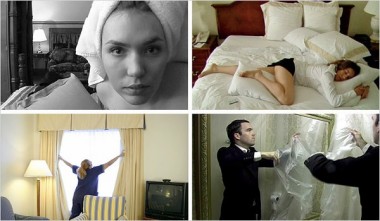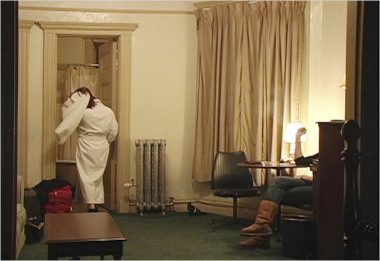ART
Hotel Rooms Become Overnight Stars
By Linda Yablonsky, The New York Times

Stills from 7 of the 45 videos in Chris Doyle's trio of installations, "50,000 Beds", shot in 30 hotel rooms.
As a staging area, a hotel room is hard to beat. With an anonymity so universal it yields a strange familiarity, its seductive blend of utility and fantasy can meet almost any need. The F.B.I. has used hotel rooms for sting operations. Couples rent them for trysts as they’re falling in love, for respite when they split apart. Travelers sleep in them. Business people meet in them. And when Greta Garbo begged to be alone, she was standing in a big one.
Of course Garbo was performing in front of a camera, but so was the young man who came to Oliver Herring’s hotel room in Connecticut a few months ago and started bouncing off the walls, tying himself in bedclothes, breaking lamps and generally making a mess in eerie silence while Mr. Herring, a total stranger, recorded it all on video.
By turns nerve-racking, touching and playful, that scene unfolds in “50,000 Beds,” a collaborative video project involving 45 artists, 30 Connecticut hotels and 3 of the state’s art institutions: the Aldrich Contemporary Art Museum in Ridgefield, Real Art Ways in Hartford and Artspace in New Haven. Conceived and designed by Chris Doyle, a Brooklyn artist whose own videos give insensate objects like lawn chairs and hot dogs what appear to be active sex lives, the project represents a new wrinkle in cultural tourism.
“I was making hotel-bed videos already,” said Mr. Doyle, 47, explaining how he came to win the commission for an exhibition to attract new viewers to the three art sites this summer. (His “Sheets,” a 2004 stop-action animation in which hotel linens toss and turn like restless sleepers, is permanently installed in the lobby of the Hotel on Rivington in Manhattan.) “I thought about extending my experience using hotels as studios, or as subject, to other artists, just to see what they would do.”
They did a lot, and the unpredictable results go on view this month in three exhibitions opening on consecutive nights at Artspace, Real Art Ways and the Aldrich. “Just making the gears mesh between the three institutions has been tricky,” said Richard Klein, exhibitions director at the Aldrich, “but Chris has been brilliant at it.”
Underwritten partly by a $90,000 grant from the Connecticut Commission on Culture and Tourism, “50,000 Beds” — the approximate number available to travelers stopping at hotels across the state — sent each artist to a participating hotel, motel or inn to make a short video during a single night’s stay.
“I’m a flight attendant who always stays in hotels, so I thought the idea was fabulous,” said Jacqueline Tarry, who collaborated with her husband, Bradley McCallum, on a video portrait of a middle-aged man who identifies himself as a sexual dominant and nearly succeeds in staring down the camera. (The hotels are not identified so that the content will not reflect on them.)
Mr. Doyle, who has a degree in architecture from Harvard and a history of large-scale public art projects, has divided the three exhibitions into 15 videos apiece and created a display structure for each. Employing a series of ramps, translucent scrims, projection screens, flat-screen monitors and the occasional bed, the structures allow viewers to move through the installations at their own pace, negotiating a path from the nightmarish to the comic, from the sexy and the fetishistic to the just plain weird.
“I didn’t know what I would get, and I didn’t doctor the results,” Mr. Doyle said of the videos, which run from 90 seconds to 23 minutes. They vary in quality and have remarkably little in common despite being shot under such similar conditions.
Consider Megan Michalak and Sarah Sharp’s macabre homage to a short story by Flannery O’Connor, the Southern gothic writer who once lived on a Connecticut farm: Their video involves a woman with a prosthetic leg and the Bible salesman who loves it. An adaptation of another sort is Melissa Friedling’s contribution, which uses the dialogue and ambience of the poker game that opens Robert Altman’s film “McCabe & Mrs. Miller” but substitutes the hedge fund managers of Greenwich for the movie’s mumbling prospectors.
“There’s this whole speech that the lawyer gives about free enterprise in the film, and then, inevitably, McCabe dies,” said Ms. Friedling, who carefully dressed her actors in Turnbull & Asser suits. “And these hedge fund guys are taking over small businesses and putting their money in the art world, so we have as ambiguous a relationship to them as Altman has to free enterprise.” A radio tuned to a Greenwich station is the only clue to the setting, an otherwise unremarkable business hotel.
No one at the hotel blinked twice at her during the shoot, she said, even though “I had all these men asking for my room number.”
Some artists chose to concentrate on the physical elements of their rooms. In “Bob Floss,” David Ellis removes a generic landscape from the wall and proceeds to repaint it a dozen different ways before returning it to the wall in its “new” condition. Tyler Coburn covers everything in his room in plastic dropcloths while a horror film starring Paris Hilton plays on the television. Marina Zurkow documents details like the door jamb, the telephone keypad and the bathroom faucet, adding animations of both human and animal figures cavorting to the “Blue Danube” waltz.
“I wanted to deal with this fantasy of leftover dreams and the detritus of other people who had inhabited the space,” she explained. “So I just followed my instinct, which was to strip down to my underwear and set up my tripod.”
Music was also important to Laurel Nakadate, known for provocative hotel-room videos where she confronts strange men in chance encounters. In her perversely funny “Beds” video she appears on the porch outside her room’s glass doors, flashing her panties at a fully dressed man who is “conducting” her actions to the tune of “You Don’t Have to Say You Love Me” by Dusty Springfield.
“It could happen,” said Ms. Nakadate, who is shooting her first feature film in Kansas City, Kan. “It’s a strange scene, but I believe there are strangers who have met like that, or couples who have done that.” On the night she left New York to make the video, she happened to run into the actor Matthew Faber, a neighbor in her East Village building, and “he just got in the car and came with me,” she said.
Other artists took a more explicitly narrative approach, using their rooms as inspiration. Erika Van Natta created a photo shoot for a fictional hotel brochure; it manages to evoke a porn movie set without even suggesting any sex, though one scene does take place in a sudsy, red, heart-shaped bathtub.

John Pilson
The hotel with the most character is the Duncan in New Haven, John Pilson’s choice for a location. (Though it remains as anonymous on screen as the other hotels, this reporter discovered it when Mr. Pilson invited her to his shoot.) Mr. Pilson stays there in a $40-per-night single on the days he teaches at the Yale University School of Art, down the street.
It’s the 113-year-old hotel’s atmosphere of the historical and the serviceable that made it a great place for Mr. Pilson to work, and one day last March he moved his cameras into what the hotel calls a suite. (Besides a four-poster, it has a couch, a half-refrigerator and microwave, and a bathroom with a dripping sink.) With him was a two-student crew and a revolving cast that included his father, Allan Pilson, and his father’s oldest friend, Arnold Mendell, both lawyers and kibitzers of a very high order.
John Pilson had to work to keep up as the two older men, who have starred in two previous videos, improvised a terrifying argument between their suddenly assumed characters, the director and star of Mr. Pilson’s “Grand Hotel” style film within a film. “I can do anything you want,” the elder Mr. Pilson, stepping out of his director character, tells his director son in an accent of no discernible origin. “I can be Fellini. I can be Godard.”
Chris Wilcha, the executive producer and director of Showtime’s “This American Life,” took a more documentary approach to his collaboration with his father, a retired marketing executive for the food industry who spent most of his working life in hotels — and never walked away from one without taking whatever soap he hadn’t used. In the video Chris Wilcha accompanies his father on a housekeeping “cart raid” outside the room.
“He keeps this vast collection of soap,” the filmmaker tells the camera. “When he was a boy, his mom used to make soap in the kitchen because they were so poor they couldn’t afford to buy it.”
One aspect of Mr. Doyle’s conception of “50,000 Beds” was his concern for the often overlooked maintenance staff that cleans hotel rooms. “The idea of the hotel bed as a confluence of the tourist and the laborer is something I wrote into the proposal,” he said, noting that he has made several videos that celebrate commuters and everyday working people.
So a couple of videos address the hotel work force directly. The most affecting perhaps is Liz Cohen’s dispassionate “Head Housekeeper.” In it a stolid woman who appears to be in her 50s describes her failed efforts to revive two suicides in the hotel where she works. One was a man who soaked himself in gasoline and lighted a match. (“I was muted to the spot,” she says.) The other was a woman with terminal cancer who suffocated herself by putting a plastic bag over her head.
“That one really bothered me,” the housekeeper says. “She was killing herself because she didn’t want to be a burden. No one wants to be a burden. I’m getting to that age myself. But people go to hotels for different reasons. Sometimes it’s leisure.
Sometimes it’s not. Sometimes it’s for a purpose. And you get used to it.”
